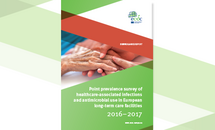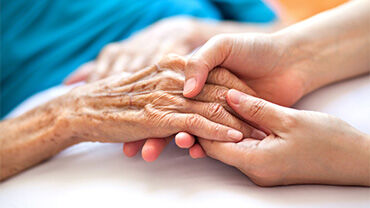Point prevalence survey of healthcare-associated infections and antimicrobial use in European long-term care facilities 2016–2017
In 2016–2017, the European Centre for Disease Prevention and Control (ECDC) organised the third point prevalence survey (PPS) of healthcare-associated infections (HAIs) and antimicrobial use in European long-term care facilities (LTCFs) or HALT-3.
Executive summary
In 2016–2017, the European Centre for Disease Prevention and Control (ECDC) organised the third point prevalence survey (PPS) of healthcare-associated infections (HAIs) and antimicrobial use in European long-term care facilities (LTCFs) or HALT-3. The design of the survey was based on the experiences and recommendations of the two previous PPSs in LTCFs organised by ECDC, i.e. HALT (2010) and HALT-2 (2013) [1, 2]. Specifically, HALT-3 used a standardised PPS methodology which aimed:
- to estimate and monitor the burden (prevalence) of HAIs and antimicrobial use in LTCFs at national and European levels;
- to measure the structure and process indicators of infection prevention and control (IPC) and antimicrobial stewardship in LTCFs;
- to identify priorities for national and local intervention measures in LTCFs, and to evaluate their implementation in Member States of the European Union (EU) and the European Economic Area (EEA).
ECDC invited EU/EEA countries and EU candidate countries to participate in one or more out of four surveillance periods: April‒June 2016, September‒November 2016, April‒June 2017 and/or September‒November 2017.
The ECDC Coordinating Competent Body (CCB) in each EU/EEA country nominated one or more persons to be Operational Contact Points (OCPs) for Epidemiology – HAIs in LTCFs (HAI-HALT). These OCPs were responsible for the organisation of the PPS at the national level, including the recruitment of LTCFs to participate in the PPS on a voluntary basis. The OCPs also classified the participating LTCFs into one of the ten distinct LTCF categories.
LTCFs were defined as facilities in which residents are medically stable, needing constant supervision (24 hours) with ‘high-skilled nursing care’ (i.e. more than ‘basic’ nursing care and assistance for daily living), and do not need constant ‘specialised medical care’ (i.e. administered by specialised physicians) or invasive medical procedures (e.g. ventilation). The following facilities were excluded: hospital long-term care wards, hostel care (hotel without any kind of nursing care), sheltered care houses, day centres, home-based centres, and protected living.
Data were collected by either a local data collector (e.g. designated physician, IPC doctor/nurse, head nurse, etc.) or an external data collector. Ideally, data collectors collected PPS data from each LTCF on one single day. In LTCFs with a large number of beds, data could be collected over two or more consecutive days, but all beds in one unit/ward had to be surveyed on the same day.
The HALT-3 protocol contained data collection forms for LTCFs and LTCF residents [3]. The LTCF forms were used to collect aggregate, LTCF-level denominator data, including demographic data, risk factors and care load indicators, as well as LTCF-level structure and process indicators of IPC and antimicrobial stewardship.
Residents were eligible, and could therefore be included in the survey, if they were living full-time (24 hours a day) in the LTCF and were present at 8:00 am on the day of the PPS and not discharged from the LTCF at the time of the survey. The resident-level forms collected data from residents receiving at least one antimicrobial agent and/or presenting at least one active HAI on the day of the PPS.
In contrast to the previous HALT surveys, in HALT-3, data were collected not only for the HAIs associated with the current LTCF, but also for HAIs acquired in other healthcare facilities, e.g. an acute care hospital or another LTCF. For such cases, the onset of symptoms had to occur >48 hours after the resident was (re-)admitted to the current LTCF, or <48 hours after the resident was (re-)admitted to the current LTCF from another healthcare facility (e.g. LTCF or hospital). Data on the detected microorganisms were recorded for residents who had one or more active HAIs on the day of the PPS. Antimicrobial susceptibility results were recorded for selected bacterium-antimicrobial combinations [3].
The resident-level forms were used to collect data on antimicrobial use for pre-specified groups of antimicrobial agents, up to Anatomical Therapeutic Chemical (ATC) level 4. These were antibacterials for systemic use (ATC level J01), antimycotics for systemic use (J02) and antifungals for systemic use (D01BA), antibiotics used as intestinal anti-infectives (A07AA), antiprotozoals (P01AB) and antimycobacterials (J04A) when used for treatment of mycobacteria including tuberculosis, or as reserve treatment for multidrug-resistant bacteria.
The HALT-3 PPS was performed by 24 countries/administrations and two EU candidate countries (North Macedonia and Serbia). Results from the EU candidate countries are presented separately in the tables and figures, and are not included in the aggregate results presented in this report.
France, the Netherlands, Norway and Sweden provided ECDC with a systematic random sample of data they had acquired through their own national PPS of HAI and antimicrobial use in LTCFs (the Netherlands, according their own protocol). France and Norway did not collect data on all HAIs because of their national protocols, so the missing data were imputed from the European averages from HALT-3. Cyprus and Czechia only collected data at the LTCF level. As a result, no detailed information on antimicrobial use or HAI data can be presented in this report for these countries. Czechia collected these data in January‒March 2018, a later period that is not covered in this report.
Twenty-four EU/EEA countries submitted data for 3 052 LTCFs, of which 85.7% were general nursing homes, residential homes or mixed facilities. Eight countries had recruited notably large numbers of LTCFs. Therefore, to avoid their overrepresentation in the European dataset, a systematic random sample was drawn from the nursing homes, residential homes and mixed facilities. This resulted in the exclusion of some LTCFs from these countries: Belgium (n=165 excluded LTCFs), Germany (n=131), Finland (n=175), France (n=367), Hungary (n=262), Ireland (n=224), Italy (n=418), and Spain (n=53).
The final European HALT-3 dataset included 117 138 eligible residents from 2 232 LTCFs. General nursing homes, residential homes and mixed LTCFs represented 80.5% (n=1 797/2 232 LTCFs) of all participating LTCFs. Data from these relatively similar types of LTCFs are aggregated in the ‘Results’ section of this report, to promote comparability of national results. The results of the more specialised LTCFs (i.e. psychiatric LTCFs, LTCFs for mentally or physically disabled persons, rehabilitation centres, palliative care facilities, sanatoria, and ‘other’ LTCFs) are presented in a separate sub-chapter.
The majority of residents were female (overall median: 70.0%) and were older than 85 years (overall median: 50.0%). The median care load in LTCFs was high: the overall median prevalence of incontinence for urine and/or faeces was 69.3% of all the residents, 59.3% were disoriented (in time and/or space), and 48.8% suffered from an impaired mobility (i.e. wheelchair-user or bedridden).
The median size of the LTCFs (general nursing homes, residential homes and mixed LTCFs) was 43 beds. The overall median percentage of single-bed rooms among the total number of LTCF beds was 80.2%, while 46.0% of all beds were in single-bed rooms that had individual toilet and washing facilities.
The majority (71.0%) of LTCFs had at least one person with IPC training at their disposal, and 39.1% had an IPC committee. An external IPC team was reported as being available to provide support and advice to 84.6% of the LTCFs. Almost all (93.9%) LTCFs reported having a written hand hygiene protocol. Hand disinfection with alcohol solution was the most frequently reported hand hygiene method (70.3%). The median use of alcohol-based hand rub was 4.3 litres per 1 000 resident-days (mean: 32.7 liters/1 000 resident-days).
Of all the LTCFs with data, 28.5% did not have any of the ten specified antimicrobial stewardship elements in place. The two most commonly reported elements were, ‘therapeutic formulary, comprising a list of antibiotics’ (45.6%) and ‘written guidelines for appropriate antimicrobial use (good practice) in the facility’ (39.4%). A restrictive list of antimicrobials for prescription was only available in 24.0% of the LTCFs.
It was more common for LTCFs to have surveillance of antimicrobial-resistant microorganisms (41.5%), than surveillance of HAIs (35.5%) or antimicrobial consumption (31.0%).
The crude prevalence of residents with at least one HAI was 3.7%. The majority of the reported HAIs (n=3 858) were associated with the current LTCF (84.7%), while 7.5% and 1.4% were associated with a hospital or another LTCF, respectively. When only taking into account the HAIs that were associated with the current LTCF, the crude prevalence of residents with at least one HAI was 3.1%.
The most frequently reported HAIs associated with the current LTCF were respiratory tract infections (RTIs, 34.8%, of which 68.1% were lower RTIs other than pneumonia), urinary tract infections (UTIs, 32.5%), and skin infections (21.2%, of which 80.8% were cellulitis/soft tissue/wound infections). More than half of the UTIs (56.1%) were ‘probable’ UTIs, i.e. cases where the resident had enough signs/symptoms to suspect a UTI, but without microbiological confirmation (i.e. urine culture not done, or result negative, or not available at the time of the survey).
The overall percentage of HAIs with documented positive microbiological results at the time of the survey was 19.2%, which is relatively low. No microbiological examination had been performed for 46.7% HAIs, while for 29.1% HAIs the microbiological results were not available or unknown at the time of the survey. No microorganism was identifiable in cultures from 4.1% HAIs, and cultures were reported to have been negative, i.e. sterile for 0.9% HAIs. The proportion of HAIs with available microbiological data varied considerably between countries/administrations, and the results from HALT-3 on the isolated microorganisms should be interpreted with caution. The most frequent microorganisms reported in HAIs were Escherichia coli (30.7%), Staphylococcus aureus (12.3%), Klebsiella pneumoniae (9.8%), Proteus mirabilis (9.5%), and Pseudomonas aeruginosa (7.1%).
The overall crude prevalence of residents with at least one antimicrobial agent was 4.9%. Details on antimicrobial prescriptions were provided for 5 006 residents and 5 344 antimicrobial agents. Antimicrobials were mainly administered orally (88.1%) and prescribed within the LTCF itself (77.9%). An end or review date was documented in the residents’ records for the majority (64.6%) of antimicrobial prescriptions.
Antimicrobial treatment (69.5%) was the main indication for antimicrobial prescribing. Prophylaxis accounted for 29.4% and the indication was unknown for 1.1% of the antimicrobials. Prophylactics were mainly used for UTIs (74.0%), while antimicrobial treatment was most frequently used for RTIs (37.2%), UTIs (34.4%) and skin or wound infections (15.8%).
Antibacterials for systemic use (ATC J01) represented 95.4% of all reported antimicrobials. The most frequently used classes within this group were penicillins (J01C; 30.2%), ‘other antibacterials’ (J01X; 18.6%), quinolones (J01M; 14.9%), sulfonamides and trimethoprim (J01E; 13.3%) and other beta-lactams (J01D; 12.6%).
Fifteen antimicrobial agents accounted for 75% of the total use in the participating LTCFs. The most
frequently prescribed antimicrobials were amoxicillin and enzyme inhibitor (J01CR02; 13.7%), nitrofurantoin (J01XE01; 9.5%) and trimethoprim (J01EA01; 9.0%).
A multivariable linear regression model, which accounted for the variety of LTCF and resident characteristics, explained 20% and 21% of the variation of the prevalence of HAIs and antimicrobial use in LTCFs, respectively. A higher prevalence of HAIs and/or antimicrobial use was independently associated (p<0.05) with explored care load indicators and risk factors. The prevalence of both HAIs and antimicrobial use were associated with the number of LTCF beds in the facility, the percentage of residents older than 85 years, being wheelchair-bound or bedridden, having a wound other than a pressure sore, and the presence of urinary or vascular catheters. Additionally, HAI prevalence was associated with being disoriented in time and/or space; and the prevalence of antimicrobial use
was associated with being male or having had surgery in the previous 30 days. A one percent increase in the proportion of residents with a vascular catheter, with wounds other than pressure sores, or with a urinary catheter was associated with an increase in HAI prevalence of 25%, 10% and 4%, respectively. For context, it is worth noting that these risk factors were relatively rare in LTCFs, i.e. the overall median proportion of vascular catheters, wounds other than pressure sores and urinary catheters was 0.0%, 3.5% and 5.6%, respectively.
The data collected during the third PPS (HALT-3) of HAIs and antimicrobial use in European LTCFs had several limitations. Many of these arose from the voluntary nature of participation in this survey at both
country/administration and local level, as well as the relatively small size of the national teams available to work on HAIs and antimicrobial use in LTCFs. For example, although the national representativeness of the LTCF sample was classified as either ‘good’ or ‘optimal’ in 18 out of 26 countries/administrations, only three countries (France, Norway and Sweden) were able to draw a systematic random sample. All three obtained these from their national (HALT-like) PPS datasets.
It is important to note that the representativeness of a country/administration sample was not related to the quality of the survey in a country/administration, but rather to the extent to which the national results can be extrapolated to the entire country/administration. Feedback from participating countries/administrations indicates that HALT-3 supported national efforts to raise awareness of IPC in LTCFs and beyond; knowledge that can also disseminate to the professional networks of LTCF staff.
Secondly, while data validity was high for antimicrobial use, the PPS sensitivity for capturing HAIs was somewhat lower and is likely to have led to a slight underestimation of HAI prevalence. Moreover, the inclusion in the HALT-3 protocol of HAIs associated with other healthcare facilities and the option to report HAIs as ‘imported’, increased the complexity of the HALT-3 protocol leading potentially to an underestimated prevalence with the current LTCF with HAIs attributed to other healthcare facilities.
Notwithstanding these limitations, repeated PPSs are useful for monitoring trends in HAIs and antimicrobial use over time, and for estimating the burden of HAIs and antimicrobial use in LTCFs at national and European levels. The total annual number of HAIs in general nursing homes, residential homes and mixed facilities in the EU/EEA was estimated at 4.4 million (cumulative 95% confidence interval: 2.0‒8.0 million).
The following areas of priority for LTCFs were identified for those working at the national and EU levels:
- Recommend to LTCFs that they participate in periodic PPSs of HAIs and antimicrobial use (Member State level);
- Enhance the level of IPC training among healthcare workers in LTCFs (Member State level);
- Reinforce access to external IPC support and expertise for LTCFs (Member State level);
- Encourage hand disinfection with alcohol-based hand rub as the main hand hygiene method, and increase awareness of the importance of hand hygiene in the prevention and control of HAIs and antimicrobial-resistant microorganisms (EU and Member State levels);
- Develop guidance for the detection and control of multidrug-resistant organisms in LTCFs and have guidelines available at national and LTCF levels (Member State level);
- Tailor basic antimicrobial stewardship programmes to improve antimicrobial prescribing in LTCFs (Member State level):
- to rationalise the use of antimicrobials for prophylaxis;
- to promote appropriate microbiological sampling in LTCFs;
- to improve access to microbiological results for LTCF staff in charge of the residents’ nursing care.
- Ensure appropriate use of antimicrobial agents for UTIs:
- by promoting alternatives to the use of antimicrobials for the prevention of UTIs in LTCFs (EU and Member State levels);
- by developing guidance for UTI diagnosis in the elderly residents, that distinguishes asymptomatic bacteriuria from symptomatic UTIs (EU and Member State levels);
- by putting down guidelines for the treatment and prevention of UTIs at national and LTCF levels (EU and Member State levels);
- by implementing the surveillance of UTIs and antimicrobial use for UTIs, at LTCF level (Member State level).
- Continue to study the association between the structure and process indicators of IPC and antimicrobial stewardship in European LTCFs, to support the production of evidence-based LTCF-specific guidelines (EU and Member State levels).
The HALT-3 PPS also made the following recommendations for PPSs in LTCFs, in the future:
- Continue to monitor HAIs and antimicrobial use using a standardised methodology across Europe
- Continue to provide training to LTCF staff to harmonise the interpretation of case definitions;
- Explore additional measures to promote the participation of LTCFs in these PPSs and also their associated validation studies;
- Promote, in collaboration with national authorities, the importance of having a robust national/regional registry of LTCFs and LTCF beds, to enable the calculation of burden estimates of HAIs and antimicrobial use in LTCFs;
- Continue to ensure compatibility with previous PPSs in adaptions to the HALT protocol, while removing any indicator(s) deemed to have a too high cost/benefit ratio. For example, the utility of collecting data on HAIs associated with stays in other healthcare facilities and the option to report HAIs as ‘imported infections’ should be critically evaluated.
- ECDC should consider producing a data entry software for PPSs in LTCFs incorporating feedback from users during the HALT-3 PPS.







